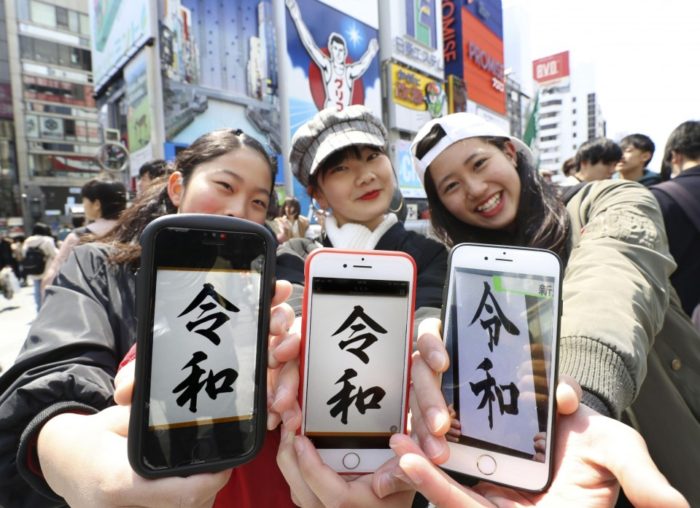Published in the Nikkei Asian Review 1/4/2019
A new era is dawning – and for once that is a no idle cliché. April 30th marks the close of Japan’s Heisei era, which began in 1989. On Monday, its successor was officially named Reiwa, a poetic expression taken from the Manyoshu, a 1300-year-old collection of poetry.
The rei of Reiwa normally means order, but in the poetic context connotes the season of plum blossom viewing, while the wa means harmony / peace. Interestingly, this is the first of Japan’s 249 era names to have been taken from an indigenous, as opposed to classical Chinese source.
Japan’s system of gengo (eras) is as satisfyingly complicated and opaque to outsiders as British place names that are pronounced very differently from their spelling, like Cholmondeley and Worcester.
For example, Showa 64 lasted for just the first week of 1989, before Emperor Showa, known to the world as Hirohito in his lifetime, passed away. From the second week of 1989, Japan entered the time-zone of Heisei 1. Hideo Yokoyama’s 64, a successful novel and film, tells the story of a crime that happened in that week-long year that otherwise left little trace.
Even those who should know better sometimes get confused, as did a fraudster and the bank he scammed some ninety years ago. The insurance policy the crook forged as proof of identity was dated June Showa 1 (1927), but Emperor Taisho died and was succeeded by his son in late December of that year. Thus Showa 1, like Showa 64, lasted only a week and June of Showa 1 is a month that never existed. In the court case, the bank lost its suit to get the money back, apt punishment for failing to spot the mistake and flunking such a basic test of Japaneseness.
The coming of the Reiwa era will likely provide some useful exercise in mental arithmetic too. Consider the multi-talented comedian-movie director “Beat” Takeshi Kitano, who was born in Showa 22. How old will he be in Reiwa 9? Finding out requires a three-stage calculation that incorporates the exact lengths of the Showa and Heisei eras. Master that and you will be in good shape to crack other recondite cultural codes. By contrast, the Western calendar version – if Takeshi was born in 1947, how old will he be in 2027? – is a walk in the park.
Like most complex systems, gengo has developed over a long period of time, starting in the seventh century. But in its current formulation, in which every era is coterminous with the reign of a single emperor, it is a modern phenomenon, dating back to the Meiji Restoration of 1868. Before that, new eras could be announced to bring closure to disturbing events, such as the series of great earthquakes that hit Japan in the mid-1850s.
When there were two competing Imperial houses in the fourteenth century, competing era names of different durations ran in parallel. Years, months and days derive from natural phenomena, but calendars are man-made, often highly political affairs – the Western Gregorian calendar being a prime example.
In the wake of defeat in the Second World War, some argued that the system should be abolished on account of its relation to the then controversial figure of Emperor Hirohito. But in the post-war years the Emperor re-invented himself as a highly popular symbol of national unity and the gengo system ran alongside the Western calendar as a symbol of how peaceful nationalism can co-exist with respect for the international order.
Starry-eyed progressive ideas of instituting a “New Japan” calendar with a base year of 1946 went nowhere. Likewise, the Shinto-derived calendar which had its base year as 660 BC, supposedly marking the accession of Japan’s first Emperor, fell out of favour due to its association with militarism and ultra-nationalism. If Japan had won the war, swathes of East Asia might now be in Koki 2679.
Historically, Japan was not unique in grouping years in a series of auspiciously named eras. All countries within the Chinese zone of influence did the same. One by one, however, China, South Korea and Vietnam adopted the Western calendar, with North Korea adding its “juche” calendar based on Kim Il Sung’s birth year. Japan may have been the first Asian country to modernize, but it did not buy the whole deal.
Like the old British measurements – gallons, quarts, yards, stones, etc – which may return one day if Brexit ever happens, the gengo system rejects the efficiency of global standardization in favour of cultural specificity and historical continuity.
It also provides a different concept of time. Instead of the relentless forward march of numbers that the Western calendar charts, there are a series of irregular sequences that all ultimately revert to ”1”.
This cyclicality may be inconvenient for planners, but is more in accord with human experience. Eras do not last forever and neither do we.
Likewise, the Western system makes the future seem predictable and mappable; we know how many decades there will be in the twenty first century and what the date will be exactly sixty years from now. Under gengo the future is radically uncertain. We have no idea how many eras will unfold or what they will be called. The year that will be known as 2079 in the West is a blank slate.
The continuing existence of gengo may have seemed an anachronism in the immediate post-war years, but it now seems forward-looking. The ability to live unfazed in both Japanese time and Western time is an inspiring example of the cultural double-tracking that will be essential in today’s multi-polar, multi-perspective world.



